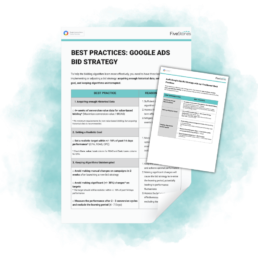Automated bidding in Google Ads is meant to grant efficiency. Bid strategies like Maximize Conversions or Target ROAS (tROAS) manage bid adjustments to help you reach your goals faster.
That said, PPC managers know that even embedded with AI & machine-learning, bid strategies don’t always turn out how you expect it to.
For this blog post, we want to recap how bidding success shouldn’t rely on just switching on automation— you need the right setup, realistic expectations, and truth be told: disciplined management.
Why “Good” Bid Strategies Underperform
Automated bidding algorithms rely heavily on input signals. If your campaign environment isn’t stable, you may get underperforming bid strategies.
Here are three main reasons why automated bidding can struggle:
1. Lack of Historical Data
Algorithms need enough historical data to properly learn. Without it, bidding decisions become unstable, and you’d be seeing campaign results fluctuating for weeks.
2. Unrealistic Performance Targets
Setting a target CPA or ROAS that’s too aggressive—especially compared to past campaign performance—forces the algorithm to learn based on unrealistic outcomes. This can slow optimization or even suppress delivery.
3. Interrupted Learning
Bid strategies need a stabilization window to learn. Frequent changes to settings, such as budgets, campaign goals, or targets during this period can reset learning, leading to unstable performance and wasted spend.
Why Bid Strategy Management Often Goes Off Track
Even with automation, bid strategies still need human oversight and input. From what we’ve seen in our customer’s bid strategy implementations, there are a few recurring challenges that affect performance:
Misaligned Strategy and Campaign Goals
It’s more common than you’d think—teams want to drive conversions but set the campaign to Maximize Clicks. When the bid strategy doesn’t reflect the right goal, performance insights become misleading, and the budget gets misallocated.
Activating Automation Without Data
Automated bidding relies heavily on historical data to learn effectively. But new campaigns are often launched with automated strategies before any baseline performance is available, making target setting a kind of guessing game.
Unrealistic Performance Targets
Targets like tCPA or tROAS are sometimes set too aggressively at the start— and sometimes never reviewed after launch. Without adjusting to actual performance, the algorithm can’t optimize effectively.
Too Many Changes
Frequent edits, such as changing budgets, targets, or bid strategies—can reset the learning phase and prevent the algorithm from stabilizing. This leads to performance swings and missed optimization windows.
The good news? These challenges are avoidable with the right framework and a bit of discipline. If there isn’t a proper process when it comes to bidding setup, learning and optimisation, you’re more likely to experience challenges like above.
Next Steps: Ready to Strengthen Your Bidding Strategy?
We’ve created a practical Best Practice guide, tailored for PPC managers using Google Ads. It walks you through how to review your current bid strategies, manage learning phases more effectively, and set realistic goals that lead to greater stability. You’ll also gain an understanding of how Search Ads 360 (SA360), an advanced enterprise search management platform, can provide the additional control you need to optimise performance at scale.

Download our Best Practice guide and review in detail if your bid strategy has these 3 core best practices:
- Having enough historical data: How much is enough?
- Having realistic goals - with actual benchmark ranges for CPA, ROAS, and CPC
- Having uninterrupted algorithms - what should you do during a "quiet" period?
